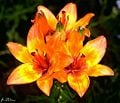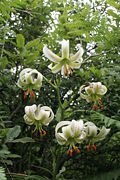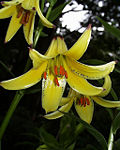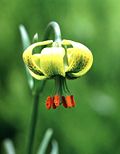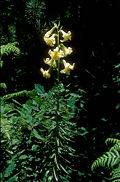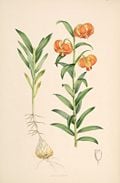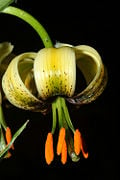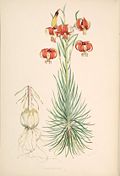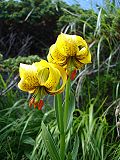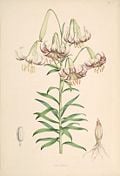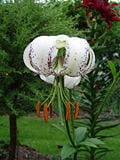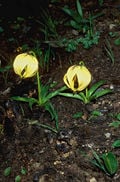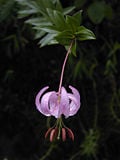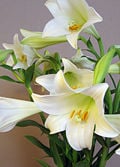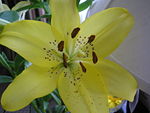Lilium
- "Lily" redirects here.
- "Lilies" redirects here.
| Lilium | ||||||||||||
|---|---|---|---|---|---|---|---|---|---|---|---|---|
| Lilium michiganense (Michigan lilies) Lilium michiganense (Michigan lilies)
| ||||||||||||
| Scientific classification | ||||||||||||
| ||||||||||||
|
See text |
The genus Lilium are herbaceous flowering plants normally growing from bulbs, comprising a genus of about 110 species in the lily family, Liliaceae. They are important as large showy flowering garden plants, and in literature. Some of the bulbs have been consumed by people. The species in this genus are the true lilies, while other plants with lily in the common name are related to other groups of plants.
Range
Lilies are native to the northern temperate regions. Their range in the Old World extends across much of Europe, the north Mediterranean, across most of Asia to Japan, south to the Nilgiri mountains in India, and south to the Philippines. In the New World they extend from southern Canada through much of the United States.
They are commonly adapted to either woodland habitats, often montane, or sometimes to grassland habitats. A few can survive in marshland and a single one is known to live as an epiphyte (L. arboricola). In general they prefer moderately acidic or lime-free soils.
Botany
Lilies are usually erect leafy stemmed herbs. The majority of species form naked or tunic-less scaly underground bulbs from which they overwinter. In some North American species the base of the bulb develops into rhizomes, on which numerous small bulbs are found. Some species develop stolons. A few species form bulbs at or near the soil surface .
Many species form stem-roots. With these, the bulb grows naturally at some depth in the soil, and each year the new stem puts out adventitious roots above the bulb as it emerges from the soil. These roots are in addition to the basal roots that develop at the base of the bulb.
The large flowers have three petals along with three petal-like sepals, often fragrant, and come in a range of colours ranging through whites, yellows, oranges, pinks, reds, purples, bronze and even nearly black. Markings include spots, brush strokes and picotees.
The plants are summer flowering. Most species are deciduous, but Lilium candidum bears a basal rosette of leaves for much of the year. Flowers are formed at the top of a single erect stem, with leaves being borne at intervals up the stem.
Some species formerly included within this genus have now been placed in other genera. These include Cardiocrinum and Nomocharis.
Taxonomy
[1], [2], [3], [4], [5], [6], [7]
Section Martagon
 |
Lilium distichum | |
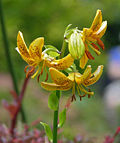 |
Lilium hansonii | |
| Lilium martagon | Martagon or Turk's cap lily | |
| 120px | Lilium medeoloides | |
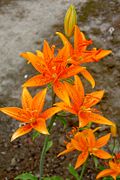 |
Lilium tsingtauense | |
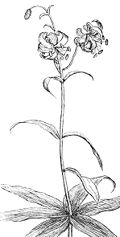 |
Lilium debile |
Section Pseudolirium
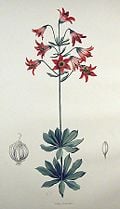 |
Lilium bolanderi | |
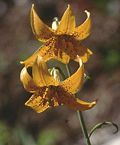 |
Lilium columbianum | Columbia Lily or Tiger Lily |
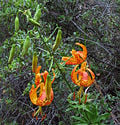 |
Lilium humboldtii | Humboldt's lily |
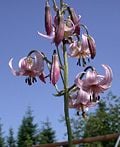 |
Lilium kelloggii | |
 |
Lilium rubescens | |
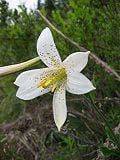 |
Lilium washingtonianum | Washington Lily, Shasta Lily, or Mt. Hood Lily |
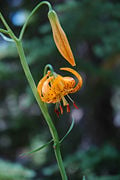 |
Lilium kelleyanum | |
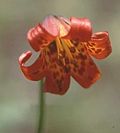 |
Lilium maritimum | |
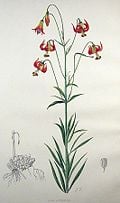 |
Lilium occidentale | |
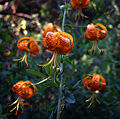 |
Lilium pardalinum | Panther or Leopard lily |
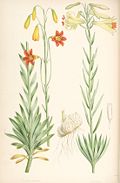 |
Lilium parryi | |
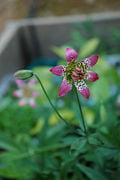 |
Lilium parvum | Sierra tiger lily or Alpine lily |
 |
Lilium canadense | Canada Lily or Meadow Lily |
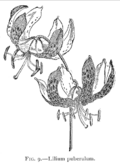 |
Lilium puberulum | |
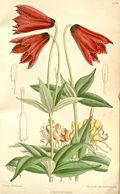 |
Lilium grayi | |
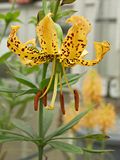 |
Lilium iridollae | |
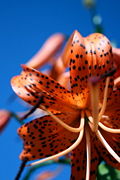 |
Lilium michiganense | Michigan Lily |
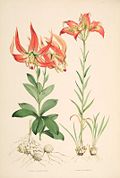 |
Lilium michauxii | Carolina Lily |
| Lilium pyrophilum | ||
| 120px | Lilium superbum | Swamp lily or American tiger lily |
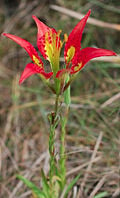 |
Lilium catesbaei | |
 |
Lilium philadelphicum | Wood lily, Philadelphia lily or prairie lily |
Section Liriotypus
Section Archelirion
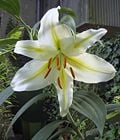 |
Lilium auratum | Golden rayed lily of Japan, or Goldband lily |
| Lilium platyphyllum | ||
| Lilium brownii | ||
| Lilium japonicum | ||
| Lilium nobilissimum | ||
| Lilium rubellum | ||
 |
Lilium speciosum | Japanese lily |
Section Sinomartagon
Section Leucolirion
Section Daurolirion
| Lilium pensylvanicum | |
| Lilium maculatum |
Uses
Many species are widely grown in the garden in temperate and sub-tropical regions. Sometimes they may also be grown as potted plants. A large number of ornamental hybrids have been developed. They can be used in herbaceous borders, woodland and shrub plantings, and as a patio plant.
Some lilies, especially Lilium longiflorum, as well as a few other hybrids, form important cut flower crops. These tend to be forced for particular markets; for instance, L. longiflorum for the Easter trade, when it may be called the Easter lily.
Lilium bulbs are starchy and edible as root vegetables, although bulbs of some species may be very bitter. The non-bitter bulbs of L. lancifolium, L. pumilum, and especially L. brownii (Chinese: 百合干; pinyin: bǎihé gān) are grown at large scale in China as a luxury or health food, most often sold in dry form. They are eaten especially in the summer, for their ability to reduce internal heat. They may be reconstituted and stir-fried, grated and used to thicken soup, or processed to extract starch. Their texture and taste draw comparison with the potato, although the individual bulb scales are much smaller.
Although they are believed to be safe for humans to eat, there are reports of nephrotoxicosis (kidney failure) in cats which have eaten some species of Lilium and Hemerocallis [1].
Lilies are used as food plants by the larvae of some Lepidoptera species including The Dun-bar.
Classification of garden forms
Numerous forms are grown for the garden, and most of these are hybrids. They vary according to their parent species, and are classified in the following broad groups;
- Species (Division IX). All natural species and naturally occurring forms are included in this group.
- Asiatic hybrids (Division I). These are plants with medium sized, upright or outward facing flowers, mostly unscented. They are derived from central and East Asian species.
- Martagon hybrids (Division II). These are based on L. martagon and L. hansonii. The flowers are nodding, Turk's cap style (with the petals strongly recurved).
- Candidum hybrids (Division III). This includes hybrids of L. candidum with several other mostly European species.
- American hybrids (Division IV). These are mostly taller growing forms, originally derived from L. pardalinum. Many are clump-forming perennials with rhizomatous rootstocks.
- Longiflorum hybrids (Division V). These are cultivated forms of this species and its subspecies. They are most important as plants for cut flowers, and are less often grown in the garden than other hybrids.
- Trumpet lilies (Division VI), including Aurelian hybrids. This group includes hybrids of many Asiatic species, including L. regale and L. aurelianse. The flowers are trumpet shaped, facing outward or somewhat downward, and tend to be strongly fragrant, often especially night-fragrant.
- Oriental hybrids (Division VII). These are based on hybrids of L. auratum and L. speciosum, together with crossbreeds from several mainland Asiatic species. They are fragrant, and the flowers tend to be outward facing. Plants tend to be tall, and the flowers may be quite large. An example is Lilium "Stargazer".
- Other hybrids (Division VIII). Includes all other garden hybrids.
Propagation and growth
Liliums can be propagated in several ways;
- by division of the bulbs,
- by growing-on bulbils which are adventitious bulbs formed on the stem,
- by scaling, for which whole scales are detached from the bulb and planted to form a new bulb,
- by seed; seed germination patterns are variable and can be complex.
Names
The botanic name Lilium is the Latin form and is a Linnaean name. The Latin name is derived from the Greek leirion, which is generally assumed to be the Madonna lily. [2]
ReferencesISBN links support NWE through referral fees
- ↑ Taxonomical division in sections follows: Harold Comber, 1949. "A new classification of the genus Lilium." Lily Yearbook, Royal Hortic. Soc., London. 15:86-105.
- ↑ Taxonomy basically from: Govaerts, R. (2006). World Checklist of Liliaceae. The Board of Trustees of the Royal Botanic Gardens, Kew. Published on the Internet; http://www.kew.org/wcsp/ accessed 15 September 2006; 20:36 GMT
- ↑ Taxonomy of Section Pseudolirium from: Flora of North America, Vol. 26, Online
- ↑ Taxonomy of Section Liriotypus in consideration of: I. Resetnik, Z. Liber, Z. Satovic, P. Cigic, T. Nikolic: Molecular phylogeny and systematics of the Lilium carniolicum group (Liliaceae) based on nuclear ITS sequences, in: Plant Systematics and Evolution, 265: 45–58 (2007)
- ↑ Taxonomy of Chinese species (various sections): Flora of China, Vol. 24, Online
- ↑ Taxonomy of Section Archelirion in consideration of: Nishikawa Tomotaro, Okazaki Keiichi, Arakawa Katsuro, Nagamine Tsukasa: Phylogenetic Analysis of Section Sinomartagon in Genus Lilium Using Sequences of the Internal Transcribed Spacer Region in Nuclear Ribosomal DNA, in: 育種学雑誌 Breeding science, Vol.51, No.1, pp. 39-46
- ↑ Taxonomy of Section Archelirion in consideration of: Nishikawa Tomotaro, Okazaki Keiichi, Nagamine Tsukasa: Phylogenetic Relationships among Lilium auratum Lindley, L. auratum var. platyphyllum Baker and L. rubellum Baker Based on Three Spacer Regions in Chloroplast DNA, in: 育種学雑誌 Breeding science, Vol.52, No.3, pp. 207-213
See also
Lily Seed Germination types
RHS Lily Group Seed Exchange [3]]
External links
- Flora Europaea: Lilium
- Flora of China: Lilium
- Flora of Nepal: Lilium species list
- Flora of North America: Lilium
- Online Lily Register, over 9400 entries Lilium
- de Florum: Lilium species
- North American Lily Society
- Royal Horticultural Society Lily Group
- [4] [5] [6] Time-lapse videos
Gallery
Credits
New World Encyclopedia writers and editors rewrote and completed the Wikipedia article in accordance with New World Encyclopedia standards. This article abides by terms of the Creative Commons CC-by-sa 3.0 License (CC-by-sa), which may be used and disseminated with proper attribution. Credit is due under the terms of this license that can reference both the New World Encyclopedia contributors and the selfless volunteer contributors of the Wikimedia Foundation. To cite this article click here for a list of acceptable citing formats.The history of earlier contributions by wikipedians is accessible to researchers here:
The history of this article since it was imported to New World Encyclopedia:
Note: Some restrictions may apply to use of individual images which are separately licensed.
